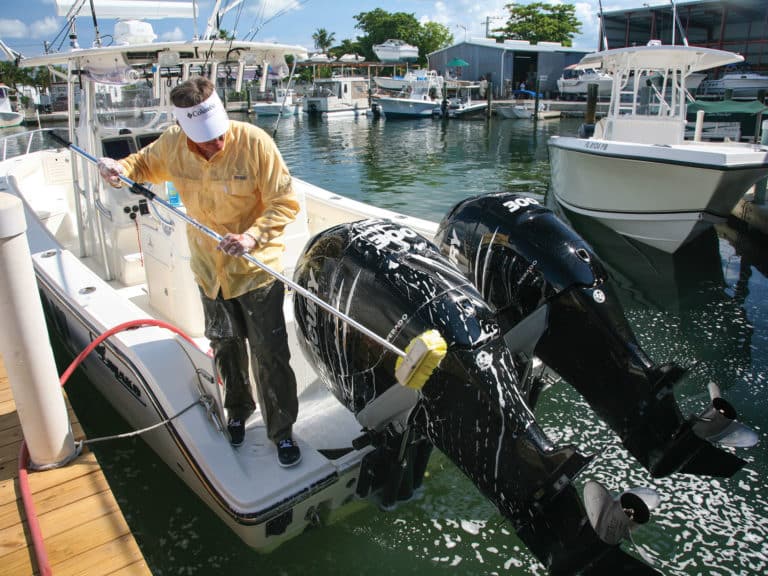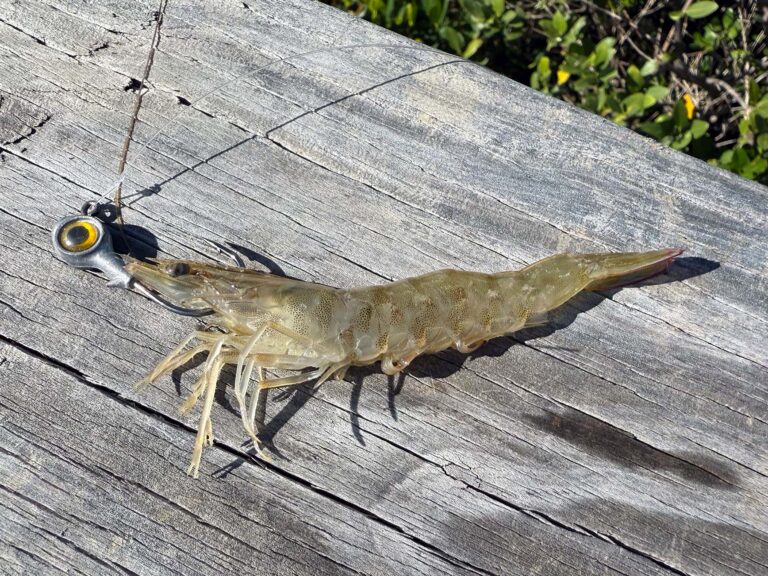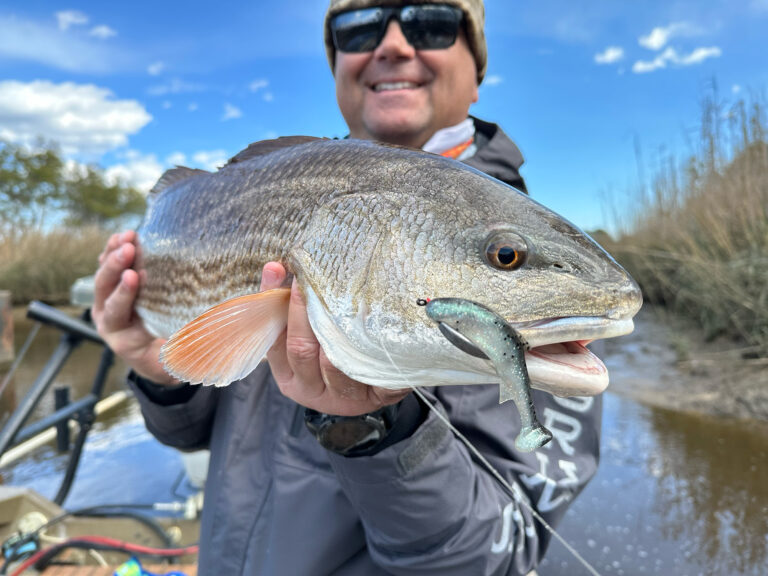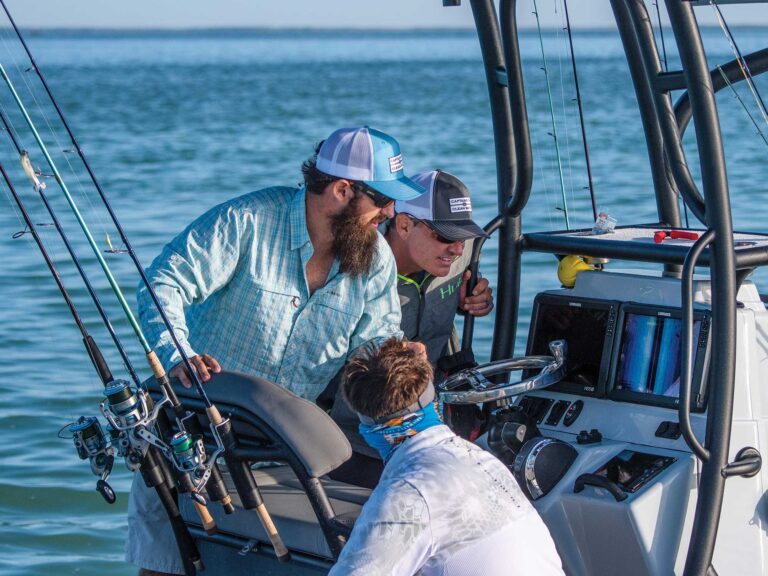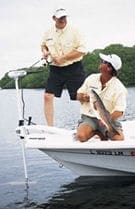
| While older trolling motors didn’t last long in the salt, today’s marine-grade models feature urethane-encased electronics, watertight housings, corrosion-free composite shafts and enough power to best a hard-running current. |
Electric trolling motors are not new to salt water, but the kind of fishing they are called on to do today, and the quality of the motors themselves, bear little resemblance to the early days. Electrics made their debut in the salt a couple of decades ago, on the back of Florida guide skiffs in the Keys and at Homosassa. Tarpon fishermen hung a pair of them on the transom to provide the extra oomph that a pushpole couldn’t quite deliver when working against a hard-running tide or chasing down fast-moving fish. While these early electrics certainly helped propel a boat across the flats, they were not without their shortcomings – namely power and durability.
The Corrosion Battle
In those early days, anglers had to make do with motors designed for fresh water. Dressing them up for use in the ocean was as critical as milking every last ounce of power from their meager little bass-oriented motors. Corrosion was a major problem. Getting an electric ready to hit the salt was strictly an aftermarket proposition. Part of the ritual was a near-complete disassembly in order to coat every metal part and electrical connection with silicone bathtub sealant. The housing then needed to be reassembled and sealed with the same goop to keep out moisture. Sometimes it even worked for a season or two.
Switches and shafts, housings and mounts were all susceptible to corrosion. What the salt water didn’t seep into and destroy, galvanic corrosion took care of. There never seemed to be enough bathtub sealant and WD-40 to stay ahead of the game. You did what you could and accepted the fact that maintenance was a constant and losing battle.
Electric Advantages
It’s not just tarpon hunters in the Southeast who are finding that electric trolling motors can boost their fishing success. Anybody who needs to sneak up on fish, or control a boat and fish at the same time, will find that the new breed of salt-tolerant electrics can drastically increase their enjoyment and fishing time.
Skiff fishing, and especially flats fishing, has traditionally been a team sport – one guy gets to fish while the other has to do time on the pushpole. In the early days, electrics were used to supplement the poler’s efforts. This is still an effective setup, but it’s a far better arrangement for professional guides than for everyday recreational fishermen. A quiet, powerful trolling motor frees one angler of boat-handling chores so he can wield a rod instead of a pushpole.
There are about as many ways to set up a trolling-motor system as there are boats. A bow-mounted motor forms the backbone of just about any salt water system where freedom to fish is the priority. Spin and plug casters may opt for the traditional foot-control arrangement. Fly casters can forgo this and simply nudge the tiller handle around with their knee.
If you need a lot of push, you can add transom motors for power and switch them on and off for steering. Or you can add a bow-mount for control.
Many Uses
Scott Deal of Maverick Boats in Fort Pierce, Florida, has probably rigged – and fished – about as many trolling-motor setups as anyone on the water. Not surprisingly, trolling motors are a necessary part of his personal fishing strategy.


Minn Kota’s Riptide line of marine-grade electrics come in both bow- (above) and stern-mounted versions (below).|
“I have bow-mounts on both my boats,” he says. “They work just great, and I can tarpon-fish by myself if I want to. I poke along, slip up on the fish and throw flies to them.”
On the flats, Deal uses the electrics mostly to control drift. “You’re not going to run up on tailing bonefish with them,” he says, “and the one thing you can’t do as well with electrics as you can with a pushpole is stop quickly. You mostly use them to keep the boat oriented as you drift along the flat, like when you are redfishing.”
Deal has also used electrics offshore in specialized situations. “When I’m fishing for dolphin on my 21-footer, I’ll use the electric to work along weed lines. If I need to call the fish in, I pull the motor up so the prop is half out of the water. It makes that pop-pop-pop sound and the dolphin come running. I think it sounds like a school of feeding fish to them. It’s an unusual way to use trolling motors, but it works great for me.
“I also use electrics to slow-troll live baits along the beach for tarpon and kingfish. I use them for everything. I can’t fish without them up here!”
Though manufacturers have been designing trolling motors for the marine market for quite some time, one of the more aggressive players is Minn Kota. For years, this company has dominated the fresh water market. Now it wants a piece of the salt water action, and it’s coming on strong. Recently, Minn Kota introduced three new motors in the Riptide series with features and innovations that demand attention.
Protection and Durability
As mentioned, corrosion control is the name of this game. This is one area where Riptide motors really shine. Shawn Showcatally, design engineer for Riptide Products, lives and breathes corrosion testing. The foundation of the company’s lab-testing program, he explained, is to replicate the wear and tear experienced in real-world conditions.
“If we get a product back that has been three years in the field, and we can determine that 2,000 hours in the spray tank equals three years in the field, we can set standards for the lab tests that correlate to reality. Then we can use that correlation to put a better product out there, quicker. Essentially, we can eliminate one round of field testing and get a better product in the fisherman’s hands sooner.”
The weakest link in electric trolling motors has always been the electronics. The delicate parts in the heads of trolling motors start to corrode with the first breath of salt air. Riptide has addressed this problem with urethane potting, which means that the electronic boards are completely sealed inside a half-inch coating of water-impervious material. It’s such a thick, effective barrier against moisture that the boards function perfectly well when submerged. “This process ends the replacement of boards, which has been a constant problem,” says Showcatally.
Galvanic corrosion is another nemesis of trolling motors. All of Riptide’s motors feature composite shafts rather than stainless steel. There’s nothing about these shafts that can corrode. Perhaps more importantly, when composites are used for the shaft it means there is one less piece of metal in the galvanic chain. Non-metallic shafts drastically reduce the electrolytic destruction that takes place below the waterline. This provides a huge advantage over stainless shafts, according to Showcatally, since stainless leads to heavy galvanic corrosion on the lower unit.
Composite shafts provide another advantage: If you hit a coral head, rock or oyster bar, they flex and spring back to shape rather than bend and crimp. In fact, Riptide covers its composite shafts with a lifetime guarantee.
Increased Battery Life
The new Riptide motors are powerhouses, offering 55, 65 and 101 pounds of thrust. The price for this push, however, is power; these motors draw 12, 24 and 36 volts, respectively, a situation that creates its own design challenges.
Dave Samek, design engineer with Riptide explains: “Once you get above a certain thrust, you need to step up the voltage to reduce current and increase the run time. Above 55 pounds of thrust you have to go to a 24V system. Still, with higher-draw motors such as the 74- and 101-pound-thrust motors, conservation of battery power is critical.”
| ¿ Trolling Motor Manufacturers Minn Kota, (262) 884-1500 http://www.minnkota.net ¿ MotorGuide, (918) 446-1461 http://www.motorguide.com ¿ Lenco Marine, (561) 288-2662 http://www.lencomarine.com |
Conventional technology would have demanded a substantial bank of batteries to power the larger of these motors. The older trolling motors utilized a speed coil, which maintained a fairly constant draw of power and bled off the excess at lower speeds, where it was converted to heat and dissipated into the water – kind of like putting on the brakes without taking your foot off the accelerator. But here’s where another innovation enters the picture. It’s called pulse-width modulation (PWM), and, put simply, it draws power on demand from the batteries. It’s not a proprietary system with Riptide. It’s the way the industry deals with high-thrust electrics and their increased power needs.
“Producing high thrust creates power-supply problems,” Samek says. “If you want the most battery life, you have to use some kind of controller. PWM extends the battery life because energy is not wasted at slow speeds – it only takes what it needs.”
PWM technology allows high-thrust motors to be used without overloading the boat with bank upon bank of batteries. “We don’t recommend using lots of batteries,” Samek explained. “With the 24V system, most fishermen have two or four batteries. With the 36V we recommend you stick with three batteries.”
With the needs of salt water fishermen serving as the impetus for innovation, we’ve never had it so good when it comes to rigging our boats. Simple, quiet and made to last, electrics are finally coming of age in salt water, and the payoff is more fishing time.





